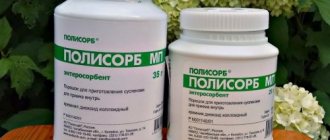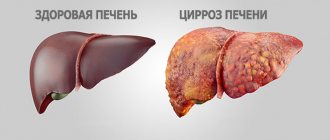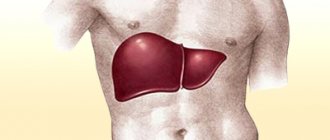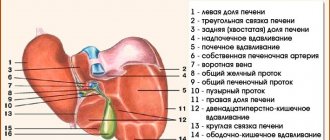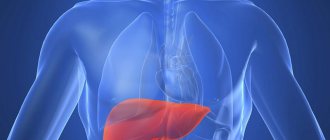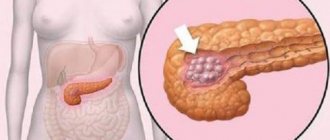According to the ICD 10th revision, the following liver disorders are distinguished:
- By 70. Alcohol disease
- To 70.0. Alcoholic fatty infiltration
- To 70.1. Alcoholic hepatitis, toxic
- By 70.9. Alcohol disease, unspecified
Liver diseases
combines various disorders of the structure of the parenchyma and the functional state of the hepatocyte caused by the systematic consumption of alcoholic beverages.
Alcoholic liver diseases
are classified as toxic.
Related information: coding for alcoholism, therapeutic plasmapheresis, withdrawal from binge drinking
Highlight:
- adaptive alcoholic hepatopathy , which is the initial stage of the disease, is established on the basis of histomorphological and electron microscopic examination of biopsy specimens (hypertrophy of the smooth endoplasmic reticulum, sharply enlarged mitochondria, hepatocytes with frosted glassy cytosol, Mallory bodies - specific hyaline);
- Alcoholic fatty liver disease (fatty hepatosis)
is the most common form of alcohol-related disease.
Etiology
The causes of fatty hepatosis are multifactorial and polyetiological. There are primary and secondary pathologies.
Among the main causes of primary hepatosis are:
- obesity;
- hyperlipidemia;
- endocrinological pathologies, namely diabetes mellitus (directly type II).
The development of secondary hepatosis is facilitated by factors such as:
- long-term use of medications with hepatotoxic potential: non-steroidal anti-inflammatory drugs, methotrexate, glucocorticosteroids, tetracycline, amiodarone, etc.;
- malabsorption syndrome, which develops with extended resection of the small intestine, ileojejunal anastomosis or stoma, gastroplasty for obesity and other surgical interventions of the gastrointestinal tract;
- rapid weight loss;
- vegetarianism with incorrect consumption of carbohydrates;
- long-term parenteral nutrition with an imbalance of carbohydrates and fats;
- chronic pathologies of the gastrointestinal tract, accompanied by malabsorption;
- abetalipoproteinemia;
- intestinal bacterial colonization syndrome;
- lipodystrophy of the limbs;
- radiation exposure.
Since fatty hepatosis is a multifactorial pathology, the causes of its occurrence may be the following risk factors:
- female;
- persistent hypertension;
- thrombocytopenia;
- uncompensated type 1 diabetes mellitus.
The disease can also be triggered by the presence of certain genetic diseases, for example, Wilson-Konovalov disease, Weber-Christian pathology, etc.
Regardless of the underlying cause of the disease, insulin resistance is present in fatty hepatosis.
Non-alcoholic liver steatosis, diagnosis, treatment approaches
Non-alcoholic liver steatosis (non-alcoholic fatty liver disease (NAFLD), fatty liver, fatty liver, fatty infiltration) is a primary liver disease or syndrome formed by excessive accumulation of fats (mainly triglycerides) in the liver. If we consider this nosology from a quantitative point of view, then “fat” should be at least 5–10% of the liver weight, or more than 5% of hepatocytes should contain lipids (histologically) [1].
If you do not intervene during the course of the disease, then in 12–14% NAFLD transforms into steatohepatitis, in 5–10% of cases into fibrosis, in 0–5% fibrosis transforms into cirrhosis of the liver; in 13% of cases, steatohepatitis immediately transforms into liver cirrhosis [2].
These data make it possible to understand why this problem is of general interest today; if the etiology and pathogenesis are clear, then it will be clear how to most effectively treat this common pathology. It is already clear that in some patients this may be a disease, and in others it may be a symptom or syndrome.
Recognized risk factors for developing NAFLD are:
- obesity;
- diabetes mellitus type 2;
- fasting (sharp weight loss > 1.5 kg/week);
- parenteral nutrition;
- presence of ileocecal anastomosis;
- bacterial overgrowth in the intestines;
- many drugs (corticosteroids, antiarrhythmic drugs, antitumor drugs, non-steroidal anti-inflammatory drugs, synthetic estrogens, some antibiotics and many others) [3–5].
The listed risk factors for NAFLD show that a significant part of them are components of metabolic syndrome (MS), which is a complex of interrelated factors (hyperinsulinemia with insulin resistance - type 2 diabetes mellitus (type 2 diabetes), visceral obesity, atherogenic dyslipidemia, arterial hypertension, microalbuminuria, hypercoagulability, hyperuricemia, gout, NAFLD). MetS forms the basis of the pathogenesis of many cardiovascular diseases and indicates their close connection with NAFLD. Thus, the range of diseases that form NAFLD is significantly expanding and includes not only steatohepatitis, fibrosis, cirrhosis of the liver, but also arterial hypertension, coronary heart disease, myocardial infarction and heart failure. At least, if the direct connections of these conditions require further study of the evidence base, their mutual influence is undoubtedly [6].
Epidemiologically, there are primary (metabolic) and secondary NAFLD. The primary form includes most conditions that develop with various metabolic disorders (they are listed above). The secondary form of NAFLD includes conditions that are formed by: nutritional disorders (overeating, starvation, parenteral nutrition, trophological deficiency - kwashiorkor); medicinal effects and relationships that are realized at the level of hepatic metabolism; hepatotropic poisons; intestinal bacterial overgrowth syndrome; diseases of the small intestine accompanied by indigestion syndrome; resection of the small intestine, small bowel fistula, functional pancreatic insufficiency; liver diseases, including genetically determined ones, acute fatty disease of pregnant women, etc. [7–9].
If the doctor (researcher) has morphological material (liver biopsy), then three degrees of steatosis are morphologically distinguished:
- 1st degree - fatty infiltration <33% of hepatocytes in the field of view;
- 2nd degree - fatty infiltration of 33–66% of hepatocytes in the field of view;
- Grade 3—fatty infiltration of >66% of hepatocytes in the field of view.
Having given the morphological classification, we must state that these data are conditional, since the process is never uniformly diffuse, and at each specific moment we are considering a limited fragment of tissue, and we are confident that in another biopsy we will get the same Most likely, no, and, finally, the 3rd degree of fatty liver infiltration should be accompanied by functional liver failure (at least in some components: synthetic function, detoxification function, biliary capacity, etc.), which is practically not characteristic of NAFLD.
The above material highlights factors and metabolic states that may be involved in the development of NAFLD, and proposes the “two-hit” theory as a modern model of pathogenesis:
the first is the development of fatty degeneration; the second is steatohepatitis.
With obesity, especially visceral obesity, the supply of free fatty acids (FFA) to the liver increases, and liver steatosis develops (the first blow). Under conditions of insulin resistance, lipolysis in adipose tissue increases, and excess FFA enters the liver. As a result, the amount of fatty acids in the hepatocyte increases sharply, and fatty degeneration of hepatocytes is formed. Oxidative stress develops simultaneously or sequentially—a “second blow” with the formation of an inflammatory response and the development of steatohepatitis. This is largely due to the fact that the functional capacity of mitochondria is depleted, microsomal lipid oxidation in the cytochrome system is turned on, which leads to the formation of reactive oxygen species and an increase in the production of pro-inflammatory cytokinins with the formation of inflammation in the liver, death of hepatocytes caused by the cytotoxic effects of TNF-alpha1 - one of the main inducers of apoptosis [10, 11]. Subsequent stages of the development of liver pathology and their intensity (fibrosis, cirrhosis) depend on the remaining factors in the formation of steatosis and the lack of effective pharmacotherapy.
Diagnosis of NAFLD and its progression conditions (liver steatosis, steatohepatitis, fibrosis, cirrhosis)
Fatty liver degeneration is a formally morphological concept, and it would seem that diagnosis should be reduced to a liver biopsy. However, such a decision has not been made by international gastroenterological associations and the issue is being discussed. This is due to the fact that fatty degeneration is a dynamic concept (it can be activated or undergo reverse development, and can be both relatively diffuse and focal in nature). The biopsy is always represented by a limited area, and the interpretation of the data is always quite conditional. If we recognize biopsy as a mandatory diagnostic criterion, then it should be performed quite often; the biopsy itself is fraught with complications, and the research method should not be more dangerous than the disease itself. The absence of a decision on a biopsy is not a negative factor, especially since today liver steatosis is a clinical and morphological concept with the presence of many factors involved in pathogenesis.
From the data presented above, it is clear that diagnosis can begin at different stages of the disease: steatosis → steatohepatitis → fibrosis → cirrhosis, and the diagnostic algorithm should include methods that determine not only fatty degeneration, but also its stage.
Thus, at the stage of liver steatosis, the main symptom is hepatomegaly (discovered by chance or during a clinical examination). The biochemical profile (aspartate aminotransferase (AST), alanine aminotransferase (ALT), alkaline phosphatase (ALP), gammaglutamyl transpeptidase (GGT), cholesterol, bilirubin) determines the presence or absence of steatohepatitis. If the level of transaminases increases, it is necessary to conduct virological studies (which will either confirm or reject viral forms of hepatitis), as well as diagnosis of other forms of hepatitis: autoimmune, biliary, primary sclerosing cholangitis. Ultrasound examination not only reveals an increase in the size of the liver and spleen, but also signs of portal hypertension (by the diameter of the splenic vein and the size of the spleen). Less commonly used (and perhaps even known) is the assessment of fatty infiltration of the liver, which consists of measuring the “attenuation column”, the dynamics of which at different periods of time can be used to judge the degree of fatty degeneration (Fig.) (ultrasound technique is described) [12].
Earlier models of ultrasound devices assessed densitometric indicators (the dynamics of which could be used to judge the dynamics and degree of steatosis). Currently, densitometric indicators are obtained using computed tomography of the liver. When considering the pathogenesis of NAFLD, a general examination and anthropometric indicators are assessed (determining body weight and waist circumference - WC). Since MS occupies a significant place in the formation of steatosis, in diagnosis it is necessary to evaluate: abdominal obesity - WC > 102 cm in men, > 88 cm in women; triglycerides > 150 mg/dl; high-density lipoprotein (HDL): <40 mg/dL in men and <50 ml/dL in women; blood pressure (BP) > 130/85 mm Hg. st; body mass index (BMI) > 25 kg/m2; fasting blood glucose > 110 mg/dL; glycemia 2 hours after a glucose load 110–126 mg/dL; Type 2 diabetes, insulin resistance.
The data presented above is recommended by WHO and the American Association of Clinical Endocrinologists. An important diagnostic aspect is also the establishment of fibrosis and its degree. Despite the fact that fibrosis is also a morphological concept, it is determined by various calculated indicators. From our point of view, the Bonacini discriminant scoring scale, which determines the fibrosis index (IF), is a convenient method corresponding to the stages of fibrosis. We conducted a comparative study of the calculated IF index with the results of biopsies. These indicators are presented in table. 1 and 2.
Practical meaning of IF:
1) IF, assessed using a discriminant scoring scale, significantly correlates with the stage of liver fibrosis according to puncture biopsy; 2) studying IF makes it possible to assess the stage of fibrosis with a high degree of probability and use it for dynamic monitoring of the intensity of fibrosis formation in patients with chronic hepatitis, NAFLD and other diffuse hepatic diseases, including for assessing the effectiveness of therapy [13].
And finally, if a puncture biopsy of the liver is performed, it is prescribed, as a rule, in the case of differential diagnosis of tumor formations, including the focal form of steatosis. At the same time, in the liver tissue of these patients the following is detected:
- fatty liver degeneration (large-droplet, small-droplet, mixed);
- centrilobular (less often portal and periportal) inflammatory infiltration with neutrophils, lymphocytes, histiocytes;
- fibrosis (perihepatocellular, perisinusoidal and perivenular) of varying severity.
The diagnosis of NAFLD (liver steatosis) is formulated based on the combination of the following symptoms and conditions:
- obesity;
- MS;
- malabsorption syndrome (as a consequence of ileojejunal anastomosis, biliary-pancreatic stoma, extended resection of the small intestine);
- long-term (more than two weeks parenteral nutrition).
Diagnosis also involves excluding the main hepatic nosological forms:
- alcoholic liver damage;
- viral infection (B, C, D, TTV);
- Wilson–Konovalov disease (blood ciruloplasmin levels are examined);
- congenital alpha1-antitrypsin deficiency disease);
- hemachromatosis;
- autoimmune hepatitis;
- drug-induced hepatitis (drug history and withdrawal of a possible drug that forms intermediate-density lipoproteins (IDL)).
Thus, the diagnosis is formed from the definition of hepatomegaly, the identification of pathogenetic factors contributing to steatosis, and the exclusion of other diffuse forms of liver damage.
Treatment principles
Since the main factor in the development of non-alcoholic liver steatosis is excess body weight (BW), reducing BW is a fundamental condition for the treatment of patients with NAFLD, which is achieved by lifestyle changes, including dietary measures and physical activity, including in cases where the need is absent in reducing BM [14]. The diet should be hypocaloric - 25 mg/kg per day with a limitation of animal fats (30-90 g/day) and a reduction in carbohydrates (especially those that are quickly digestible) - 150 mg/day. Fats should be predominantly polyunsaturated, which are found in fish and nuts; It is important to consume at least 15 grams of fiber from fruits and vegetables, as well as foods rich in vitamin A.
In addition to the diet, you need at least 30 minutes of daily aerobic physical activity (swimming, walking, gym). Physical activity itself reduces insulin resistance and improves quality of life [15].
The second important component of therapy is the impact on metabolic syndrome and insulin resistance in particular. Of the drugs aimed at its correction, metformin has been the most studied [16, 17]. It has been shown that treatment with metformin leads to an improvement in laboratory and morphological indicators of inflammatory activity in the liver. Insulin sensitizers are used in type 2 diabetes, but a meta-analysis did not show any benefit from their effect on insulin resistance [18].
The third component of therapy is to avoid the use of hepatotoxic drugs and drugs that cause liver damage (the main morphological substrate of this damage is liver steatosis and steatohepatitis). In this regard, it is important to take a drug history and avoid drug(s) that damage the liver.
Since bacterial overgrowth syndrome (SIBO) plays an important role in the formation of liver steatosis, it must be diagnosed and corrected (drugs with antibacterial action - preferably non-absorbable; probiotics; motility regulators, liver protectors), and the choice of therapy depends on the initial pathology , which forms SIBO.
Today, the issue of using liver protectors is not resolved entirely correctly. There are works that show their low efficiency, there are works that show their high efficiency. It appears that their use does not take into account the stage of NAFLD. If there are signs of steatohepatitis, fibrosis, or cirrhosis of the liver, then their use seems justified. I would like to present analytical data on the basis of which and depending on the number of factors involved in the pathogenesis of NAFLD, a hepatoprotector can be selected (Table 3).
From the presented table it is clear (the most commonly used protectors are introduced, if desired, it can be expanded by introducing other protectors) that ursodeoxycholic acid preparations (Ursosan) act on the maximum number of pathogenetic links of liver damage.
We would like to present the results of Ursosan treatment of patients with NAFLD. 30 patients were studied (15 of them had obesity as the basis, 15 had MS; there were 20 women, 10 men; age from 30 to 65 years (average age 45 ± 6.0 years).
The selection criteria were: increase in AST level - 2–4 times; ALT - 2–3 times; BMI > 31.1 kg/m2 in men and BMI > 32.3 kg/m2 in women. Patients received Ursosan at a dose of 13–15 mg/kg body weight per day; 15 patients for 2 months, 15 patients continued taking the drug for up to 6 months. The results of treatment are presented in table. 4–6.
The exclusion criteria were: viral nature of the disease; concomitant pathology in the stage of decompensation; taking drugs that can potentially form (maintain) fatty liver degeneration.
Group 2 continued to receive Ursosan at the same dose for 6 months (with normal biochemical parameters). At the same time, appetite stabilized, and body weight gradually (1 kg/month) decreased. According to ultrasound data, the structure and size of the liver did not change significantly, the dynamics along the “attenuation column” continued (Table 6).
Thus, according to our data, the use of liver protectors in patients with NAFLD in the stage of steatohepatitis is effective, which is reflected in the normalization of biochemical parameters and a decrease in fatty infiltration of the liver (according to ultrasound, a decrease in the “attenuation column” of the signal), which in general is an important justification for their use.
Literature
- Morrison YA et al. Metformin for weight loss in pediatric patients taking psychotropic drugs // Am. Y Psychiatry. 2002. vol. 159, p. 655–657.
- Quote by: Shchekina M.I. Non-alcoholic fatty liver disease // Cous. Med. T. 11, No. 8, p. 37–39.
- Isakov V. A. Statins and the liver: friends or enemies // Clinical gastroenterology and hepatology. Russian edition. T. 1, No. 5, 372–374.
- Diche AM NaSH: bench to bedside — lesons from aminal models. Presentation at the Session Falk Symposium 157, 2006.
- Lindor KD Jn on behalf of the UDCA/NASH Study group. Ursodeoxycholic acid for treatment of nonalcocholic steatohepatitis: results of a randomized, placebo-controlled // Trial gastroenterology. 2003, 124 (Suppl): A-708.
- Drapkina O. M., Korneeva O. N. Non-alcoholic fatty liver disease and cardiovascular risk: the influence of female gender // Pharmateka. 2010, no. 15, p. 28–33.
- Shchekina M.I. Non-alcoholic fatty liver disease // Cons. Med. T. 11, No. 8, 37–39.
- Bueverov A. O., Bogomolov P. O. Non-alcoholic fatty liver disease: rationale for pathogenetic therapy // Clinical perspectives of gastroenterology and hepatology. 2000, no. 1, 3–8.
- Savelyev V.S. Lipid distress - a syndrome in surgery. Materials of the 8th open session of the Russian Academy of Medical Sciences. M. S. 56–57.
- Carieiro de Mura M. Non-alcoholic steatohepatitis // Clinical perspectives of gastroenterology, hepatology. 2001, No. 3, p. 12–15.
- Augulo P. Non-alcoholic fatty liver disease // New Engl. Y Med. 2002, vol. 346, p. 1221–1231.
- Sokolov L.K., Minushkin O.N. et al. Clinical and instrumental diagnosis of diseases of the organs of the hepatopancreato-duodenal zone. M., 1987, p. 30–39.
- Minushkin O. N. et al. Possibilities of clinical and laboratory assessment of liver fibrosis. In the book: Selected issues of clinical medicine. T. III. M., 2005, p. 96–102.
- Berrram SR, Venter Y, Stewart RY Weight loss in olese women exercise v. dietary education // S. Afr. Med. Y. 1990, 78, 15–18.
- Hickman Yg et al. Modest weight loss and physical activity in overweight patient with chronic liver disease result in suctaned improvements in alanine aminotransferase, fasting insulin, and quality of life // Gut. 2004, 53, 413–419.
- Bugianesi E. et al. A randomized controlled trial of merformin versus vitamin E or prescriptive diet in nonalcoholic fatty liver disease // Am. G. gastroenterol. 2005, vol. 100, No. 5 b, t. 1082–1090.
- Uygun A. et al. Metformin in the treatment of patients with non-alcoholic steatogepatitis // Phormacol Ther. 2004, vol. 19, no. 5, p. 537–544.
- Augelico F. et al. Drugs improving insulin resistance for non-alcogolic fatty liver disease and/or non-alcogolic steatogepatitis // Cochrane Database Syst Rev. 2007. CD005166.
O. N. Minushkin, Doctor of Medical Sciences, Professor
FSBI UMTS Administrative Department of the President of the Russian Federation, Moscow
Contact information about the author for correspondence
Pathogenesis
The pathogenetic process of fatty hepatosis has not been sufficiently studied. Clinically, it is generally accepted that fatty hepatosis directly precedes the development of non-alcoholic fatty liver disease. The development of the disease, the actual accumulation of lipids, may be a consequence of:
- Increased intake of free fatty acids into the liver tissue.
- A sharp decrease in the rate of b-oxidation of acids in hepatic mitochondria.
- Increased synthesis of fatty acids in hepatomitochondria.
At the same time, the process of removing fat from the liver is hampered due to reduced synthesis of lipoproteins and the elimination of triglycerides in their composition.
Next, steatohepatitis is formed, accompanied by inflammatory-necrotic liver changes. This is the conditional “first push”. The role of the “second push” is associated with the use of certain groups of medications, which are a source of radicals that stimulate oxidative stress and the production of inflammatory mediators. As a result, microcirculation and metabolic processes are disrupted, liver ducts become clogged, and degenerative tissue changes develop.
General information
Fatty liver disease is also known as fatty liver, fatty liver, or hepatic steatosis (mistakenly known as liver stenosis). It is considered an independent syndrome or disease that is caused by fatty degeneration of liver cells. In the 60s of the last century, it was isolated as an independent disease after the introduction of puncture biopsy of liver tissue into practice.
The pathology is characterized by the deposition of fatty droplets in the extra- and (or) intracellular space of the liver. A morphologically important criterion for hepatosis is the content of triglycerides in the hepatic system above 10% of dry weight.
With non-alcoholic steatohepatitis, there is the same increase in liver enzymes and identification of specific morphological changes in liver biopsies, as with alcoholic hepatitis , with the only difference that patients with NASH do not abuse alcohol-containing drinks in volumes that can cause such damage to hepatocytes. ICD-10 code for fatty liver disease: K70.0 Alcoholic fatty liver [fatty liver]
Clinical symptoms
The disease at the initial stage is asymptomatic. The first signs appear only after the pathological process has transitioned to pronounced fibrosis. At this stage, symptoms such as:
- significant discomfort in the right hypochondrium;
- yellowness of the skin and sclera;
- enlarged liver and spleen;
- spider veins, a symptom of “liver” palms;
- gastrointestinal dysfunction: regular nausea, episodes of vomiting and diarrhea, flatulence;
- intolerance to spicy and fatty foods;
- asthenovegetative syndrome: causeless fatigue, emotional instability, sleep disturbances, etc.
When diffuse organ damage develops, severe severe manifestations join the general symptoms:
- diffuse hemorrhages;
- stable fever;
- hypotension;
- periodic loss of consciousness;
- visual impairment;
- ascites.
If such symptoms develop, emergency hospitalization is indicated.
specialist
Our doctors will answer any questions you may have
Tumasova Anna Valerievna Gastroenterologist
Classification and stages of development
In Russian clinical practice, the working classification according to the Brunt system is used, dividing hepatosis depending on the degree, activity of inflammation, and degree of fibrosis.
According to the degree of steatosis:
- 0 degree:
the pathological process has begun, microscopic fatty compounds are present in the parenchyma, but it is impossible to diagnose the disease, since there are no symptoms, the ultrasound picture does not change the structure, the biochemical blood test is within the physiological norm; - 1st degree:
characterized by small sizes of fatty lesions, steatosis up to 33%, accumulations of degenerated hepatocytes are determined visually on ultrasound, there are no clinical symptoms; - Grade 2:
33–66% of hepatocytes are subject to fatty degeneration, infiltration foci are numerous and vary in size, and lipid inclusions inside normal hepatocytes are also detected. Ultrasound visualizes heterogeneous parenchyma, its size is increased; - Grade 3:
the vast majority of cells are replaced by lipids. The liver is enlarged, there is pronounced dysfunction, the infiltrates are voluminous and numerous, and are cystic in nature. Clinical manifestations are pronounced.
According to the degree of non-alcoholic steatohepatitis:
- I degree:
characteristic steatosis of 1–2 degrees, there is lobular inflammation in the stage of dispersion or minimal infiltration, slight balloon degeneration, portal inflammation is absent or insignificant; - II degree:
steatosis of any severity, moderate portal and lobular inflammation, slight persinusoidal fibrosis; - III degree:
pancreatic steatosis, active balloon degeneration, active lobular and portal inflammation.
According to the course of fibrosis:
- Grade 1:
focal or widespread fibrosis; - 2nd degree:
periportal; - 3rd degree:
bridge-like; - 4th degree:
liver cirrhosis.
There are also acute and chronic processes of hepatosis. Acute develops rapidly. The leading symptom is intoxication caused by a sharp decrease in the functional abilities of the organ. Liver cells quickly die, causing skin icterus, hyperthermia and vomiting. Treatment of the acute form is inpatient.
Why is fatty liver disease dangerous?
Without treatment, liver steatosis threatens to develop severe complications. They are presented:
- fibrosis. As the cells die, they are gradually replaced by connective fibers, which is accompanied by scarring of the organ. Against this background, the functioning of the liver rapidly deteriorates;
- disruption of the production and movement of bile through the excretory ducts, as a result of which cholestasis develops and the digestion process is disrupted;
- steatohepatitis, which is characterized by inflammation of the liver tissue against the background of its fatty degeneration.
Separately, we should highlight cirrhosis, which is dangerous due to its manifestations. Against the background of protein deficiency, there is a deficiency of coagulation factors, which is fraught with massive bleeding. In addition, esophageal veins undergo varicose changes. They become crimped and their walls become thinner. The patient begins to experience severe swelling of the extremities. Fluid accumulates not only in tissues, but also in cavities (pleural, abdominal), which is accompanied by symptoms characteristic of pleurisy and ascites.
Provided proper treatment and compliance with all medical recommendations, it is possible to slow down the progression of the disease and significantly improve a person’s general condition.
Treatment
The main direction in the treatment of fatty hepatosis is the reduction or elimination of the key pathogenetic factor.
Drug therapy
The main directions are:
- lipid-lowering therapy: lipotropic drugs are prescribed that eliminate fatty infiltration (folic and lipoic acids), B vitamins, essential phospholipids;
- hepatoprotection: hepatoprotectors are used to normalize the functional abilities of the liver (ursodeoxycholic acid, betaine, tocopherol, taurine, etc. Research is actively being conducted on the effectiveness of taking pentoxifylline in combination with angiotensin receptor blockers);
- reduction of insulin resistance: thiazolidinediones and biguanides are used.
In each specific situation, drugs are prescribed individually, their dosage and duration of administration are carefully selected. Priority is given to drugs of the latest generations, which have the greatest effectiveness, longevity and the least side effects.
Diet therapy
In some cases, diet is the key method of therapy. Therapeutic nutrition involves a sharp limitation of animal fats, as well as fatty and spicy foods. A protein intake of at least 100–110 g/day is indicated; an adequate supply of vitamins and microelements is necessary. It is recommended to consume fruits and vegetables enriched with fiber, with priority given to steamed dishes. The optimal diet for hepatosis is diet No. 5.
Dosed physical activity is also recommended.
Rehabilitation
The rehabilitation process requires a serious approach and time. The program is developed individually for each patient and includes correction of diet and lifestyle aimed at combating excess weight. The actions of medical workers are aimed at maximizing the quality of life, as well as preventing complications and progression of the disease.
Prognosis and prevention
Preventive measures include maintaining a healthy lifestyle with the necessary physical activity, a balanced diet and avoiding alcohol.
It is extremely important to monitor your weight; your BMI should be between 18.5 and 25. For patients with diabetes, it is important to strictly follow doctor's instructions to control the disease, closely monitor sugar levels and take medications in a timely manner.
If treatment is started in a timely manner, the prognosis for life is favorable, work ability, as a rule, is not impaired; if a complication develops, there is a risk of death.

